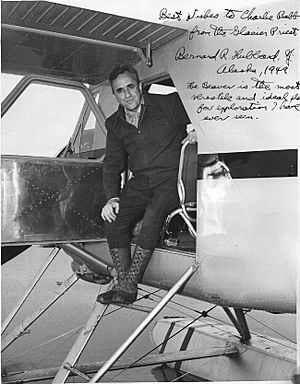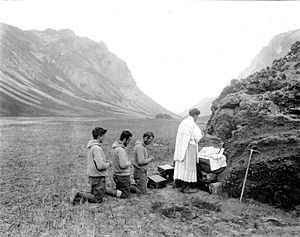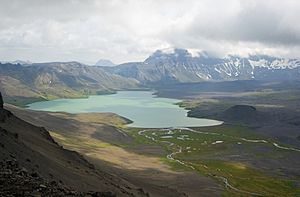Bernard R. Hubbard facts for kids
Quick facts for kids
Bernard R. Hubbard
|
|
|---|---|

Hubbard in a DHC-2 Beaver airplane, 1949
|
|
| Born |
Bernard Rosecrans Hubbard
November 24, 1888 San Francisco, California, U.S.
|
| Died | May 28, 1962 (aged 73) Santa Clara, California, U.S.
|
| Nationality | American |
| Other names | "The Glacier Priest" |
| Education | Los Angeles College |
| Alma mater | Gonzaga University (M.A.) |
| Occupation | Geologist, explorer, Jesuit priest |
Bernard Rosecrans Hubbard (born November 24, 1888 – died May 28, 1962) was an American geologist and explorer. He was famous for sharing the wonders of the Alaskan wilderness with people across America. Many knew him as "the Glacier Priest." He was also a Jesuit priest and led the geology department at the University of Santa Clara in California. For a time, he was one of the world's highest-paid speakers. He led 31 exciting trips into Alaska and the Arctic.
Contents
Bernard Hubbard's Early Life
Bernard Hubbard was born in San Francisco, California, on November 24, 1888. He grew up in Santa Cruz, California. His brother, John, became a mining engineer. Bernard went to Santa Clara College from 1906 to 1908.
In 1908, he joined the Society of Jesus, becoming a Jesuit. He studied at different colleges, including Los Angeles College. In 1921, he earned a Master of Arts degree from Gonzaga University. He then studied in Innsbruck, Austria, where he became a priest in 1923. While in Austria, he fell in love with the mountains. This is where he got his famous nickname, "Der Gletscher Pfarrer" (which means "the Glacier Priest").
Adventures as an Explorer and Speaker
In 1926, Hubbard returned to Santa Clara College. He taught German, geology, and theology. But his true passion was exploring. From 1927 to 1962, he spent his summers exploring Alaska. In the winters, he traveled around giving talks about his adventures.
He was known as the highest-paid speaker in the world in 1937. He could earn up to $2000 for one talk! Hubbard used this money to help Jesuit missions in Alaska.
Exploring Alaska's Volcanoes and Glaciers
Hubbard's first trip to Alaska was to study the Juneau Icefield. In 1929, he visited the Valley of Ten Thousand Smokes. This sparked his interest in volcanoes. In 1930, he led the first major trip to the unknown volcanic crater at Mount Aniakchak. He returned there in 1931 and again in 1932.
By chance, the Aniakchak volcano had a moderate eruption just weeks before Hubbard's second trip in May 1931. On other trips, Hubbard explored the Taku Glacier. He even crossed the Bering Strait in a canoe! In 1936, he went back to the Valley of Ten Thousand Smokes.
His 1931 trip took him down the Yukon River. He visited missions along the way. He started in winter with a 13-dog sled. Later, he took his first airplane ride along the Bering Sea coast. Hubbard and his crew flew over Aniakchak. They saw the volcano's eruption from the air. They even nearly crashed!
He met up with three college students who brought their gear to Kujulik Bay. They climbed to the volcano's crater. They explored the active crater for 33 days. On his 1932 trip, Hubbard and pilot Frank Dorbandt made history. They were the first to successfully land a plane on a lake inside a volcano. This was on Surprise Lake in the Aniakchak crater.
Documenting Alaskan Cultures
Hubbard's interests later shifted to the cultures of native Alaskans. He spent a lot of time in 1937-38 documenting the Iñupiat and Yup'ik peoples. He especially focused on the Iñupiat of King Island.
He took many still photos and made movies of King Islander life. He captured 11,000 photos and 40,000 feet of movie film. His photographs of native culture are still very important today.
Hubbard's Exciting Lectures
Hubbard was an amazing speaker. He created early multimedia shows. He used still pictures, films, and his own dramatic stories. His style was like that of writer Jack London, who also wrote about Alaska.
A story about his first visit to Aniakchak made him famous in 1930. It was called "The Moon Craters of Alaska." After the 1931 eruption, Hubbard was invited to speak in Washington. He showed "before and after" pictures of Aniakchak. He called them "Paradise Found" and "Paradise Lost." These photos helped scientists understand how plants grow back after a volcano erupts.
Hubbard turned his movie footage from 1930-1932 into a film called Aniakchak. Fox Studios distributed it, and it played all over the world. Hubbard kept a very busy lecture schedule. In 1944-45, he gave 93 talks in just 63 days! He spoke to audiences of up to 7000 people in famous places like Carnegie Hall in New York.
Later Years and Legacy
In 1930, Hubbard started working with the Alaska Packers' Association (APA). This company ran salmon canneries. Hubbard wrote good things about the salmon industry. He also made a documentary called Alaska's Silver Millions about salmon and canneries. The APA helped him with transportation for his trips.
During and after World War II, Hubbard advised the U.S. military about Alaska. He also gave talks and helped military personnel. In the late 1940s, he started Hubbard Laboratories. This company made and shared documentaries.
Hubbard had a stroke in 1955. He had more strokes in the years that followed. He passed away from his fifth stroke on May 28, 1962, at the age of 73.
Newsweek magazine remembered him as "the Glacier Priest." They noted he was a tireless Jesuit who led 32 expeditions to Alaska. He once said an explorer needs "a strong back, a strong stomach, a dumb head, and a guardian angel."
Hubbard received honorary degrees from Marquette University and Trinity College of Connecticut. He wrote three books and many stories for magazines like National Geographic.
Bernard Hubbard's Works
Books by Bernard Hubbard
- Mush, You Malamutes (1932)
- Cradle of the Storms (1935)
- Alaskan Odyssey (1952)
Movies by Bernard Hubbard
- Aniakchak (1933)
- Alaska's Silver Millions (1936)




